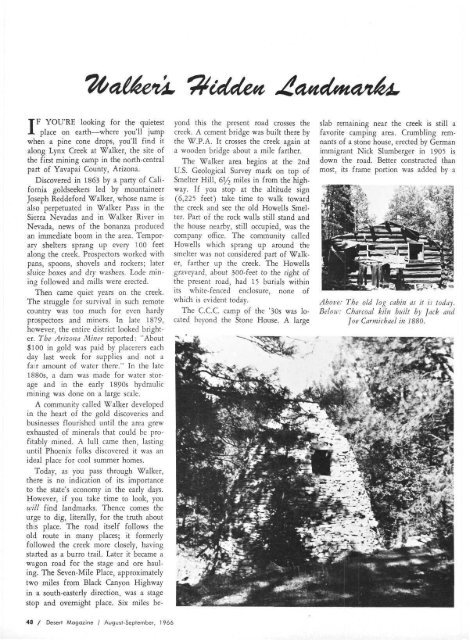AUGUST/SEPTEMBER 1 9 6 6 double issue - Desert Magazine of ...
AUGUST/SEPTEMBER 1 9 6 6 double issue - Desert Magazine of ...
AUGUST/SEPTEMBER 1 9 6 6 double issue - Desert Magazine of ...
You also want an ePaper? Increase the reach of your titles
YUMPU automatically turns print PDFs into web optimized ePapers that Google loves.
Walker's Hidden Landmarks<br />
IF YOU'RE looking for the quietest<br />
place on earth—where you'll jump<br />
when a pine cone drops, you'll find it<br />
along Lynx Creek at Walker, the site <strong>of</strong><br />
the first mining camp in the north-central<br />
part <strong>of</strong> Yavapai County, Arizona.<br />
Discovered in 1863 by a party <strong>of</strong> California<br />
goldseekers led by mountaineer<br />
Joseph Reddeford Walker, whose name is<br />
also perpetuated in Walker Pass in the<br />
Sierra Nevadas and in Walker River in<br />
Nevada, news <strong>of</strong> the bonanza produced<br />
an immediate boom in the area. Temporary<br />
shelters sprang up every 100 feet<br />
along the creek. Prospectors worked with<br />
pans, spoons, shovels and rockers; later<br />
sluice boxes and dry washers. Lode mining<br />
followed and mills were erected.<br />
Then came quiet years on the creek.<br />
The struggle for survival in such remote<br />
country was too much for even hardy<br />
prospectors and miners. In late 1879,<br />
however, the entire district looked brighter.<br />
The Arizona Miner reported: "About<br />
$100 in gold was paid by placerers each<br />
day last week for supplies and not a<br />
fa:.r amount <strong>of</strong> water there." In the late<br />
1880s, a dam was made for water storage<br />
and in the early 1890s hydraulic<br />
mining was done on a large scale.<br />
A community called Walker developed<br />
in the heart <strong>of</strong> the gold discoveries and<br />
businesses flourished until the area grew<br />
exhausted <strong>of</strong> minerals that could be pr<strong>of</strong>itably<br />
mined. A lull came then, lasting<br />
until Phoenix folks discovered it was an<br />
ideal place for cool summer homes.<br />
Today, as you pass through Walker,<br />
there is no indication <strong>of</strong> its importance<br />
to the state's economy in the early days.<br />
However, if you take time to look, you<br />
will find landmarks. Thence comes the<br />
urge to dig, literally, for the truth about<br />
this place. The road itself follows the<br />
old route in many places; it formerly<br />
followed the creek more closely, having<br />
started as a burro trail. Later it became a<br />
wagon road for the stage and ore hauling.<br />
The Seven-Mile Place, approximately<br />
two miles from Black Canyon Highway<br />
in a south-easterly direction, was a stage<br />
stop and overnight place. Six miles be-<br />
48 / <strong>Desert</strong> <strong>Magazine</strong> / August-September, 1966<br />
yond this the present road crosses the<br />
creek. A cement bridge was built there by<br />
the W.P.A. It crosses the creek again at<br />
a wooden bridge about a mile farther.<br />
The Walker area begins at the 2nd<br />
U.S. Geological Survey mark on top <strong>of</strong><br />
Smelter Hill, 61/2 miles in from the highway.<br />
If you stop at the altitude sign<br />
(6,225 feet) take time to walk toward<br />
the creek and see the old Howells Smelter.<br />
Part <strong>of</strong> the rock walls still stand and<br />
the house nearby, still occupied, was the<br />
company <strong>of</strong>fice. The community called<br />
Howells which sprang up around the<br />
smelter was not considered part <strong>of</strong> Walker,<br />
farther up the creek. The Howells<br />
graveyard, about 300-feet to the right <strong>of</strong><br />
the present road, had 15 burials within<br />
its white-fenced enclosure, none <strong>of</strong><br />
which is evident today.<br />
The C.C.C. camp <strong>of</strong> the '30s was located<br />
beyond the Stone House. A large<br />
slab remaining near the creek is still a<br />
favorite camping area. Crumbling remnants<br />
<strong>of</strong> a stone house, erected by German<br />
immigrant Nick Slumberger in 1905 is<br />
down the road. Better constructed than<br />
most, its frame portion was added by a<br />
Above: The old log cabin as it is today.<br />
Beloiv: Charcoal kiln built by Jack and<br />
Joe Carmichael in 1880.

















